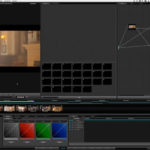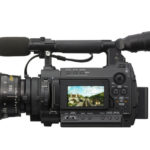
REVIEW: High Speed Cameras
Posted on Jan 4, 2011 by Alex Fice
Vision Research’s new FLEX, HD Gold and Photron’s BC2 high speed cameras
In the first of an article series MICHAEL GANSS from high speed specialists Pirate, helps you choose the right high speed camera for your next slow motion job
Phantom has become the generic term for ‘high speed camera’. When the camera first appeared some three years ago, producers would ask to hire a ‘Photosonics camera’, meaning a digital high speed camera. Now, they ask for a ‘Phantom’, and quite rightly so. The manufacturer, Vision Research, won an Emmy recently. Their Phantom HD Gold has finally moved high speed cinematography away from film for most projects. This is largely due to the huge reduction in costs and ease of use finally winning over the ‘film looks better – more latitude/detailed highlights’ argument. The nine stops of latitude (dynamic range) of the current high speed cameras is considerably worse than film and highlights do have more detail on film, but never mind the quality feel the width. Also imagine shooting 3D high speed on film!
Although the Phantom HD Gold is good, there are two other alternatives for hire in the UK which are better or worse depending on the project. They are Photron’s Fastcam BC2 and the newer camera from Vision Research, the Phantom Flex. At Pirate we compared our two Phantom HD Golds (we were the first to have them in the UK) and our Photron BC2 (also the first), with a new Phantom Flex.
At first glance, on reading the headline grabbing figures of 2570fps and 1000 ASA for the Flex, and its higher rental cost, one might assume it is the best – it is the newest after all and it is natural to assume new technology is best technology. But ‘best’ depends on the project.
Save Data or Record Video?
All digital cameras have the same basic workflow: shoot video data into camera memory, immediately playback via HD-SDI, mark an ‘in’ and an ‘out’, save the data from the camera to external data storage, which is later transcoded for postproduction. However, some outside broadcast and drama productions simply record the HD-SDI playback. The BC2 is most suited to the OB workflow, having EVS XT2 integration. Whilst this might seem like a good idea for titles or commercials too, recording in 10 bit (on a Sony SR deck, say) immediately drops information from the original images and therefore doesn’t do justice to the high quality images the cameras produce. Not surprisingly, in the three years we have been operating HD Golds, few clients have elected to record 10 bit HD-SDI with everybody else taking data for higher quality. However, it is unlikely that the difference in quality is noticeable in most productions.
Download Data or Use Mags?
High speed digital cameras have extremely fast internal memory for capturing large amounts of image data very quickly, (32GB fills in just over five seconds on a Photron BC2 shooting HD at 2000fps). The data in this memory buffer is ‘volatile’, if the camera power is interrupted, the data is lost. Each shot must be saved, usually to a hard disk, using a control computer. This takes time, up to seven minutes for a full memory save on the 16GB HD Gold, restricted by the Gigabit Ethernet cable through which it is downloaded. Whilst this may sound nerve-wracking for a precious take, it’s very seldom a problem as we power the cameras using an uninterruptible power supply (UPS) or on-board battery. Of more concern is the time delay on set since one cannot shoot again until the data has been downloaded.
Often, however, this proves not to be as significant as it might seem for three reasons; one can still have a live camera to line up the next shot, one rarely saves the full memory (the time taken being pro-rata, so half a memory buffer takes half the time) and often the studio is waiting for a reset anyway (explosions, water splashes, food shoots etc.). There are times when the ‘dreaded’ download time is highly significant, for example when shooting celebrities such as fickle footballers. This is where the Phantom cameras are better because they can be used with ‘CineMags’.
CineMags (a.k.a. ‘mags’) are unique to the Phantom cameras. Large memory blocks mounted directly on camera, they are capable of saving the full camera memory in seven seconds rather than minutes: download time is virtually eliminated. Each mag holds 21 full memory saves, which transcodes into 63 minutes of 25fps playback footage. So think of a mag as a one hour tape. In addition, if shooting at less than 450fps on the HD Gold (or 361fps on the Flex) one can save footage directly into the mag, by-passing the camera’s internal memory, facilitating very long takes. Finally, one can review shots stored in the mag, obviating the need for video playback kit on some shoots. Of course, one still needs to copy footage from the mag later, or on set using a download station. So far, so good. However, the downsides of using mags are the increased costs and a drop in data quality. The costs are three-fold: mag hire costs, hire of the download station and possibly after-shoot download labour costs too.
The drop in data quality, whilst one might argue that nobody seems to have realised it, can be shocking when first pointed out. It is a little known fact that data is stored in only 10bit log colour format on mags, not, the 14bit linear colour that the HD Gold is known for. Vision Research say the 14bit linear data is re-created when a mag is downloaded, which it is, within reason. The technical difference is not usually visible due to the bit-depth limitations of display technology, but can be an issue if the data needs to be significantly moved in post.
So, where budgets are tight or if 14bit linear data is a must, don’t use CineMags unless you have to. And if you do need to, you must use the HD Gold or the Flex.
Image Quality?
Whilst camera choice based on image quality is subjective, there are definite, significant differences between the cameras. Colour digital cameras having a single sensor with a Bayer pattern filter, such as these, suffer from colour artifacts (spurious errors in the image). A full explanation of ‘Bayer’ and artifacts is way too complicated for here, but suffice to say that Phantom HD Gold and Flex alleviate the problems using an ‘optical low pass’ (OLP) filter (a piece of fuzzy glass) in front of the sensor. This naturally produces a slightly soft, some say film-like image. In contrast, the Photron BC2 reduces artifacts by electronic processing of the image instead, giving a noticeably sharper image on the HD-SDI output. The downside of not having an OLP filter is the presence of moiré artifacts seen in fine patterns.
These Macbeth chart shots, all shot at 1920 x 1080, 1000fps, 180 degree shutter (download and judge for yourself at www.definitionmagazine.com), illustrate that the colour rendition ‘straight off the camera’ of the BC2 is superior to the HD Gold and Flex. Further, zoom in and the image noise becomes apparent: the BC2 image is the cleanest, followed by the HD Gold, with the Flex showing discernable noise even in HQ mode.
Go to the current DIGITAL EDITION to view magnified Macbeth charts and comparative tables
With the Flex, one has the choice between High Quality (HQ) mode and Standard Quality (SQ) mode. Essentially, this is a trade off between image quality and top speed/sensitivity. Even though the Flex is a newer camera, users of the Flex agree that even its HQ mode image is noisier/grainier than the HD Gold, which has the additional benefit of being 14, rather than 12, bit colour too.
Best camera for image quality: BC2, then HD Gold
Film Lenses on Digital Cameras
The width of the HD Gold sensor, at 25.6mm, is so similar to the size of 35mm film that 35mm cine lenses are a popular choice.
With the HD Gold, it is not uncommon to be accused of having an uncollimated lens mount. So much so that we carry our own collimator to shoots! For example, focus pullers would complain that lenses needed new focus marks for each stop! Indeed, some very wide lenses simply never are sharp. The problem lies not in collimation but in the interplay between digital sensors, OLP filter and ‘traditional’ 35mm film lenses. The solution lies with newer, ‘telecentric’ lenses and not using an OLP filter. This is a complex and unresolved issue, but it is clear that the presence of the OLP on the Phantoms causes more focusing issues than with the BC2.
Although the Flex has a denser pixel array, fitting about 2560 pixels into the 25.6mm width, if one shoots HD (the middle 1920 x 1080 pixels), one is using the centre of the sensor equal to the size of the BC2’s. This makes all lenses ‘longer’. Naturally most cameramen prefer to maintain the depth of field / length of their 35mm film lens, so should use the Flex in full sensor resolution (2560 x 1440 pixels). However, at this resolution, the top frame rate reduces to only 800fps in HQ mode, compared with 1267fps at 1920 x 1080 resolution. The BC2, on the other hand, tops out at 2000fps at 1920 x 1080.
Best camera: For a film-friendliness up to 1000fps – HD Gold, or BC2/Flex for depending on maximum fps required.
Sensitivity?
High speed shoots are always light hungry. The better-than-before sensitivity of the HD Gold (we rate it at 320 ASA) made digital video viable. However, cameramen always want more stop and the later generation sensor of the BC2 has twice the sensitivity (640 ASA). Whilst the Flex’s rating has yet another half stop (1000 ASA), it should be noted that at the top frame rate in HQ mode of 1267fps using the only centre 1290 x 1080 pixels, the maximum shutter allowed is 180 degrees, which effectively reduces the sensitivity to 500 ASA. It should be noted that the manufacturers quote ISO ratings which differ from our figures.
Best camera for sensitivity: BC2 or Flex
Ease of Use
The HD Gold’s success has been due to its supreme ease of use, being the most film-like high speed digital camera. Whilst the BC2 has an eye-piece and can be mounted on a bridge plate, it’s similarity with a film camera ends there. The HD Gold and now the Flex not only look the part, but they have on-camera controls, can be run on batteries and, using CineMags, can be run wire-free. Thus, the HD Gold and Flex are great for any shoot involving hand-held, cranes, long tracks and steadycams and makes location work considerably easier. With a little extra weight, one can add a wireless HD-SDI transmitter too, facilitating remote live and playback.
Best camera for ease of use: HD Gold or Flex
In Conclusion
Where a combination of image quality, lens performance and top speed are most important, use the BC2. For projects in which fast download times and ease of use are most important, use the HD Gold or Flex: choose between HD Gold or Flex depending on whether the cleaner, 14bit colour of the HD Gold is more important than the higher sensitivity or higher frame rate of the Flex.
As a footnote, I should mention that there are other high speed cameras from both manufacturers, but they are not generally available for hire here in the UK.







